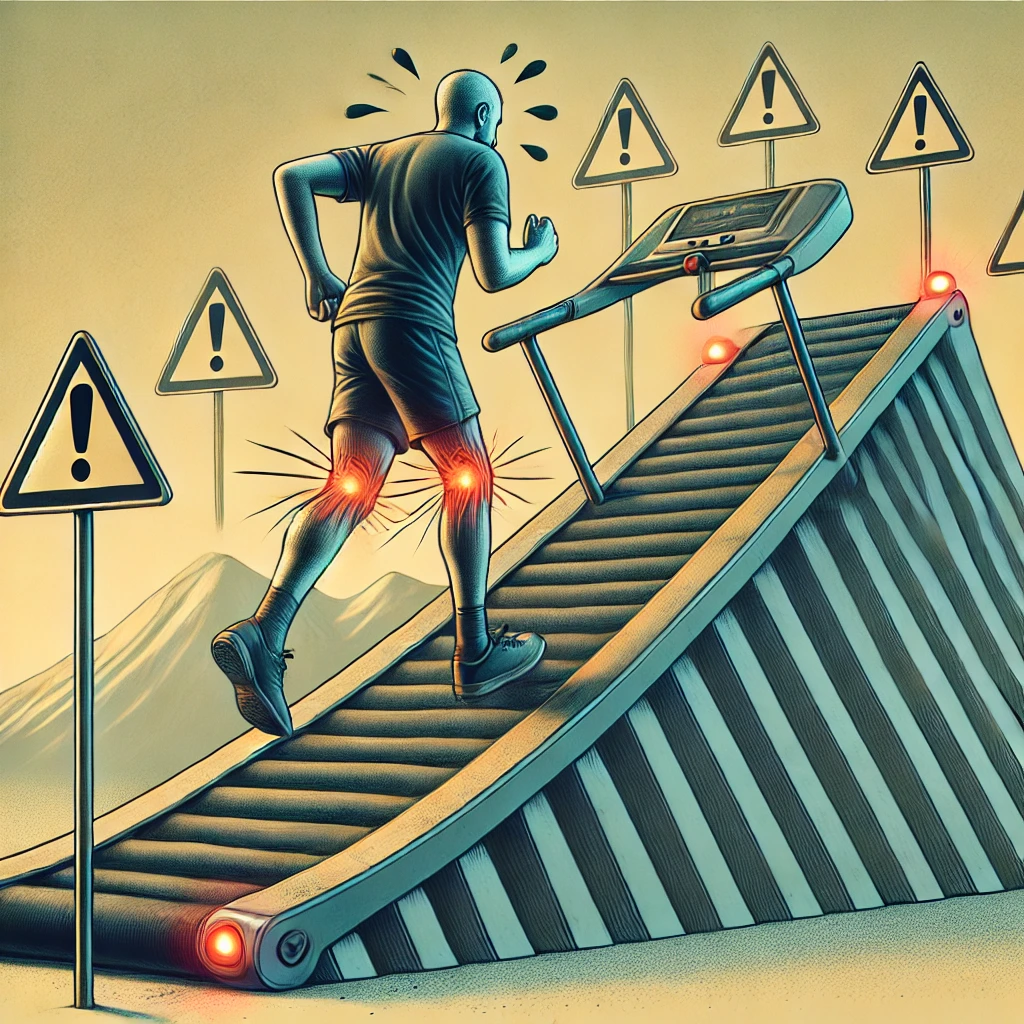Ever jumped on an incline treadmill thinking you’re about to crush the ultimate workout, only to discover it might not be the fitness wonderland you imagined? While incline training sounds like a superhero-level exercise technique, it’s not without its potential pitfalls. Most fitness enthusiasts rave about the benefits, but there’s a hidden side to these steep climbing machines that deserves a closer look.
Incline treadmills promise to torch calories and build leg strength faster than traditional flat running, but they come with a set of challenges that can catch even seasoned athletes off guard. From potential joint stress to unexpected biomechanical complications, these high-angled fitness devices aren’t always the miracle solution they’re marketed to be.

The Hidden Physical Strain
Let’s break down some critical incline treadmill disadvantages that fitness enthusiasts rarely discuss:
- Increased risk of knee and ankle joint stress
- Higher potential for muscle fatigue and overuse injuries
- Unnatural running biomechanics compared to outdoor terrain
- Potential balance and coordination challenges
While incline training isn’t inherently bad, understanding these potential drawbacks can help you make more informed workout decisions and protect your long-term fitness goals.
Physical Strain and Injury Risks
When it comes to incline treadmill disadvantages, the physical strain and injury risks can’t be overlooked. These steep machines might look impressive, but they can quickly transform from a fitness ally to a potential injury trap if you’re not careful.
Joint Stress: The Silent Nemesis
Running on a steep incline dramatically increases the biomechanical load on your joints, particularly your knees, ankles, and lower back. Unlike natural terrain variations, treadmill inclines create a repetitive, unforgiving angle that can lead to significant wear and tear.
Every degree of incline is like adding invisible weights to your joints – the higher you go, the heavier the burden.
Common Injury Hotspots
- Anterior knee pain from increased patellofemoral pressure
- Achilles tendon inflammation
- Lower back strain due to altered running mechanics
- Calf muscle overextension and potential tears
The risks amplify when users push beyond their fitness levels or ignore proper form. Many athletes mistakenly believe that steeper equals better, but this couldn’t be further from the truth.
Biomechanical Breakdown
High-incline settings force your body into an unnatural forward-leaning position. This posture can:
- Compress your spine
- Increase lower back muscle tension
- Reduce running efficiency
- Potentially trigger compensatory movement patterns
Pro tip: If you're experiencing persistent discomfort, it might be time to reassess your treadmill workout strategy. Remember, fitness is about sustainable progress, not risking long-term health for short-term intensity.
Cardiovascular Overexertion
When diving into the world of incline treadmill disadvantages, cardiovascular overexertion emerges as a critical concern that many fitness enthusiasts overlook. It’s tempting to crank up that incline and believe you’re achieving the ultimate workout, but your heart might be telling a different story.
The Hidden Heart Strain
High-incline settings dramatically increase cardiovascular demand, pushing your heart rate into potentially dangerous territory. Unlike traditional flat running, steep inclines create an exponential stress response that can quickly overwhelm your cardiovascular system.
Intensity isn't always about how hard you push, but how sustainably you can maintain your effort.
Cardiovascular Red Flags
- Rapid heart rate escalation beyond recommended training zones
- Increased risk of exercise-induced arrhythmias
- Potential oxygen debt and premature fatigue
- Compromised cardiac efficiency during prolonged high-incline sessions
The body doesn’t always signal distress immediately. What feels like an intense workout could be your cardiovascular system operating dangerously close to its limits.
Energy Expenditure Misconception
Many users mistakenly believe that higher inclines automatically translate to better fitness gains. However, the reality is more nuanced. Excessive cardiovascular stress can lead to:
- Decreased workout recovery capacity
- Increased cortisol (stress hormone) production
- Potential long-term metabolic adaptations
- Reduced overall exercise performance
Listening to your body isn’t just advice – it’s a survival strategy. A smart approach to treadmill training means understanding your personal cardiovascular limits and respecting them.
Pro tip: Consider using heart rate monitoring and gradually introducing incline variations to prevent cardiovascular overexertion. Your heart will thank you later.

Technical Limitations and Maintenance Challenges
While incline treadmills might seem like the ultimate fitness solution, they come with a complex web of technical limitations and maintenance challenges that can quickly turn your high-tech workout machine into a costly headache.
Mechanical Complexity: More Moving Parts, More Problems
Unlike standard flat treadmills, incline models feature sophisticated mechanical systems that adjust elevation. These intricate components mean more potential points of failure and significantly more complex maintenance requirements.
- Advanced motor systems for angle adjustment
- Complex electronic incline control mechanisms
- Additional hydraulic or electrical lifting components
- Increased wear on deck and belt due to angular stress
Financial Implications of High-Maintenance Equipment
The technical sophistication of incline treadmills translates directly into higher maintenance costs. Repair and replacement expenses can quickly eclipse the initial investment, making these machines a potentially expensive long-term commitment.
- Higher repair costs for specialized components
- More frequent professional servicing requirements
- Shorter equipment lifespan compared to standard treadmills
- Specialized parts that are often brand-specific
Electronic Reliability Concerns
Modern incline treadmills rely heavily on electronic systems. These digital components are vulnerable to:
- Calibration issues
- Sensor malfunctions
- Software glitches
- Electrical component failures
A single electronic failure can render your expensive workout machine completely unusable, transforming what seemed like a fitness investment into an unexpected paperweight.
Pro tip: Always consider warranty coverage and potential maintenance costs before investing in a high-end incline treadmill. Sometimes, simplicity trumps complexity in fitness equipment.
Psychological and Performance Barriers
Beyond the physical challenges, incline treadmills present a unique set of psychological and performance barriers that can significantly impact your workout motivation and overall fitness journey.
Mental Intimidation Factor
Let’s be real – the sight of a steep incline can be mentally crushing. Many fitness enthusiasts find themselves psychologically defeated before they even start, creating a powerful mental block that prevents them from fully engaging with their workout.
The steepest mountain is often the one in your mind, not on the treadmill.
Performance Anxiety Triggers
- Fear of losing balance at higher inclines
- Overwhelming perception of difficulty
- Comparison anxiety with other gym-goers
- Reduced confidence in personal fitness capabilities
The Motivation Drain
Incline treadmills can quickly become a psychological battleground. The constant struggle against gravity creates a unique form of mental fatigue that goes beyond physical exhaustion. Unlike traditional treadmill workouts, the persistent challenge of an incline can:
- Decrease workout consistency
- Increase likelihood of skipping sessions
- Create negative associations with exercise
- Trigger performance-related stress
Performance Plateau Paradox
Ironically, the very feature designed to enhance your workout can become a significant performance limiter. Constant high-incline training can lead to:
- Adaptation fatigue
- Reduced workout variety
- Mechanical running form deterioration
- Mental burnout from repetitive challenging workouts
Pro tip: Mix up your treadmill training approach. Alternating between different inclines and speeds can help maintain mental engagement and prevent psychological barriers from taking root.
Remember, fitness is as much a mental game as a physical one. The most challenging incline you’ll ever face is the one between your ears – and that’s where true fitness transformation begins.

Cost vs. Benefit Analysis
When diving into the world of incline treadmills, the financial and performance equation isn’t as straightforward as fitness marketers would have you believe. Let’s break down the real cost vs. benefit analysis that most people overlook.
The Price of Performance
Incline treadmills typically come with a premium price tag that can make your wallet weep. We’re not just talking about the initial purchase – the long-term investment includes maintenance, potential repairs, and the hidden costs of potential injury prevention.
Just because you can climb doesn't mean you should – financially or physically.
Performance Gains vs. Investment
Let’s get brutally honest about the actual fitness benefits. While incline treadmills promise enhanced calorie burn and muscle engagement, the reality is often more nuanced. The incremental gains might not justify the substantial financial and physical investment.
- Marginal calorie burn increase (5-10% more than flat running)
- Potential muscle adaptation plateau after initial weeks
- Higher risk of repetitive strain injuries
- Limited transferability to real-world terrain training
Alternative Cost-Effective Options
Smart fitness enthusiasts know that there are more budget-friendly and body-friendly alternatives to high-end incline treadmills. Consider these options that offer similar benefits with less financial and physical strain:
- Outdoor trail running with natural terrain variations
- Interval training on standard treadmill models
- Cross-training with strength and cardio mix
- Outdoor hill or stair training
Pro tip: Before investing in an expensive incline treadmill, assess your actual fitness goals. Sometimes, the simplest approach yields the most sustainable results. Remember, the best workout is the one you'll consistently do – not the one that looks most impressive in your home gym.
Bottom line: Incline treadmills aren’t inherently bad, but they’re not the universal fitness solution they’re marketed to be. Your body, bank account, and long-term fitness journey deserve a more nuanced approach.
Alternatives and Balanced Approach
Not every fitness journey requires a high-tech, steep-angled treadmill. Smart athletes know that true progress comes from balanced, adaptable training strategies that minimize risk while maximizing results. Let’s explore some intelligent alternatives and approaches that can help you achieve your fitness goals without the potential drawbacks of constant incline training.
Diversified Training Strategies
Instead of relying solely on incline treadmills, consider these more holistic workout approaches:
- Cross-terrain outdoor running
- Interval training with varied intensity
- Strength training with functional movements
- Hill and stair workouts in natural environments
Fitness isn't about conquering one machine, it's about understanding your body's unique capabilities.
Smart Incline Integration
If you’re committed to incline training, here’s how to do it safely and effectively:
- Start with minimal inclines (1-3%)
- Gradually increase angle over weeks
- Limit high-incline sessions to 10-15 minutes
- Alternate with flat and downhill training
Low-Impact Alternatives
For those seeking similar cardiovascular and strength benefits with reduced strain, explore these options:
- Low-angle treadmill walking
- Swimming and water-based workouts
- Elliptical training with resistance
- Cycling with varied terrain
Pro tip: Listen to your body. The most sustainable fitness approach is one that challenges you without causing persistent pain or potential long-term damage. Variety isn't just the spice of life – it's the secret sauce of effective, injury-resistant training.
Remember, your fitness journey is unique. What works for one person might be a recipe for frustration for another. The goal is consistent, enjoyable progress that supports your long-term health and wellness.
Understanding these incline treadmill disadvantages doesn’t mean abandoning them entirely, but approaching their use with informed caution and personalized strategy.